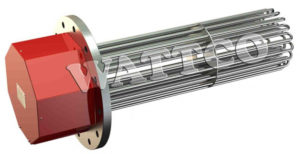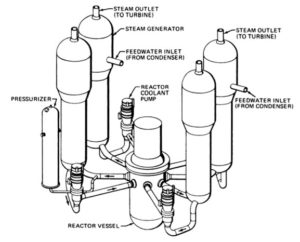The Use of Immersion Heaters in the Nuclear Power Industry
Last updated on January 9th, 2023 at 08:25 pm
The nuclear power industry serves to provide heat and electricity to consumers by harnessing the heat energy generated by nuclear fission within a controlled environment. Nuclear fission is the breakup of the nucleus of an atom into smaller parts. Within the confines of a nuclear reactor, this controlled nuclear fission reaction produces a great amount of thermal energy, which is then used to heat water into steam, which in turn moves a turbine in an electrical generator converting the thermal energy into electrical energy. [1] Nuclear energy is seen as a vital source of electricity due to the efficient nature of electricity production, and in 2010, accounted for approximately 14% of the world’s electricity demand. [2] The energy production through nuclear means requires control systems in place that monitor and adjust many parameters essential to the process. Some of these control systems require electrical heat generation using immersion heaters.

Figure 1 – A flanged immersion heater manufactured by WATTCO™ [3]
Immersion heaters are a type of electrical heater that are primarily used to heat liquids. As the name suggests, an immersion heater consists of metallic elements immersed within the liquid it is heating. The elements act as electrical resistors, which efficiently convert electrical energy into thermal energy which dissipates into the surrounding liquid thus heating it. Figure 1 shows a type of immersion heater manufactured by WATTCO™. This flanged heater uses numerous elements to increase the contact surface area with the fluid being heated to increase efficiency. [4, 5] Usually there is a sensor located within the contained liquid which sends signals to a control unit where temperature parameters are imputed to control the flanged heater. Immersion heaters are most commonly used in industrial settings. Electric heaters are commonly used to control the pressure within a pressurized water reactor, a common type of nuclear reactor, which can be seen in figure 2. In this type of nuclear reactor, a primary coolant (water at high pressure) is used to absorb the heat resulting from the controlled nuclear fission reaction. The heat is then transferred to the working fluid, which is water, using a heat exchanger. Due to the heat, the working fluid is converted to steam, which in turn drives the turbine to create electrical energy, which is ready for commercial use. Within the design of this reactor, the primary coolant must remain a liquid at a temperature of 321°C. [1] To ensure it does not boil, the loop must be maintained at a high pressure of 2250 psi. [1] To maintain and manage the overall pressure, an external vessel known as a pressurizer connected to the loop is used. The pressurizer is a tank filled with water and steam. There is an electric immersion heater located at the bottom of the tank, which can be a flanged heater. Typically, an 1800 kW capacity heater is required for a nuclear plant that produces almost 3000 MWe of electricity. [1] The steam pressure controls the overall pressure of the loop, while the pressure of the steam is controlled by the temperature of the pressurizer. When a sensor measures a drop in pressure, the electric heater is turned on. This heats the water, converting it to steam to raise the overall pressure within the loop. Thus pressure is a controlled parameter within the pressurized water reactor which is controlled by an electric heater. Should the pressure rise higher than required, a spray of cool water is discharged into the pressurizer to lower the temperature, thus lowering the amount of steam and lowering the pressure. [1, 6, 7]
 Figure 2 – A schematic of a Pressurized Water Reactor with 4 steam generators [6]
Figure 2 – A schematic of a Pressurized Water Reactor with 4 steam generators [6]
An immersion heater is an ideal type of electric heater for application inside the pressurizer due to its efficiency and versatility in size and design, as well as the simplicity in manufacture. WATTCO™ can provide custom design on immersion heaters to suit the particular application. Parameters such as element shape and size, wattage, control systems and materials can all be custom designed to suit the buyer’s needs. Maintenance on the heating elements of the pressurizer is relatively simple, and thus increases the life of the pressurizer, increasing the economic attractiveness of using an immersion heater within a pressurizer. [8] In fact, through simple cutting and welding, lone defective elements in a flanged heater can be replaced, rather than replacing the entire immersion heater. Furthermore, due to the ease of maintenance of the immersion heater, the life of a pressurizer is increased, which reduces the radiation exposure on maintenance workers during a pressurizer replacement. Stainless steel is the most appropriate material in which to fashion the elements of the immersion heaters used in pressurizers. It is a high quality metal alloy that is resistant to chemical corrosion in an aqueous environment and has good high temperature strength. It is in fact used in much of the piping within the nuclear reactor. [9] Many steel alloys display negligible changes in hardness and strength in response to nuclear irradiation, which can significantly damage other materials. [10] Furthermore, WATTCO™ can provide several alloy compositions such as Incoloy® and Inconel®, which feature heavy walled sheaths, which cope well with high wattage applications, such as heating of the pressurizer in a nuclear power plant. Electric immersion heaters are well suited to be used in the pressurizer of the pressurized water nuclear reactors due to their impressive efficiency, versatility in design simple manufacturing and maintenance techniques. Due to design considerations, mainly the high temperature, pressure and presence of constant nuclear irradiation, stainless steel is the optimal material for the elements in immersion heaters. For more information on immersion heaters, design parameters or to get a quote, please contact WATTCO™’s technical consultants.
References
- Cameron, I. R. Nuclear Fission Reactors. New York: Plenum, 1982. Print.
- World Nuclear News. “Another Drop in Nuclear Generation.” WNN. World Nuclear News, 5 May 2010. Web. 9 July 2012. http://www.world-nuclear-news.org/newsarticle.aspx?id=27665&terms=another+drop+
- WATTCO. Flanged Immersion Heater. Digital image. Flanged Heaters. WATTCO, n.d. Web. 6 July 2012. <https://www.wattco.com/product_category/flanged-heaters/>.
- Raju, K. S. N. Fluid Mechanics, Heat Transfer, and Mass Transfer: Chemical Engineering Practice. Hoboken, NJ: Wiley, 2011. Print.
- Morgan, Lemuel J., and Leonard F. Lowe. Electric Immersion Water Heater. Patent US3446939. 27 May 1969. Print.
- Glasstone, Samuel, and Alexander Sesonske. Nuclear Reactor Engineering. Vol. 2. New York, NY: Chapman & Hall, 1994. Print.
- Mendolia, Frank J. Pressurizer Heaters. Westinghouse Electrical Corporation, assignee. Patent US4135552. 23 Jan. 1979. Print.
- Loch, Emil P., and Frank J. Mendolia. Method of Repairing A Heating Element in A Pressurizer. Westinghouse Electric Corporation, assignee. Patent US4255840. 17 Mar. 1981. Print.
- Weisman, Joel. Elements of Nuclear Reactor Design. Amsterdam: Elsevier Scientific Pub., 1977. Print.
Hausner, Henry Herman, and Stanley B. Roboff. Materials for Nuclear Power Reactors,. New York: Reinhold, 1955. Print.
